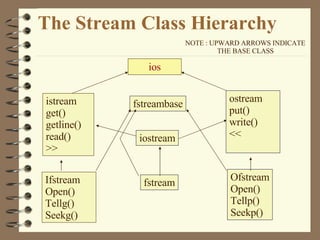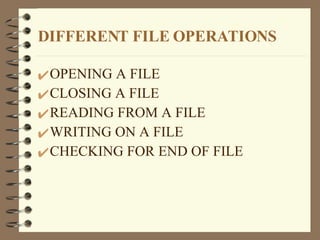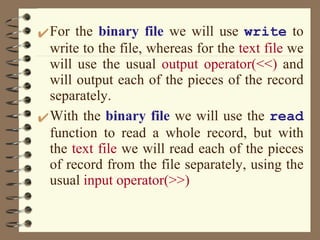This document discusses file handling in C++. It begins by explaining the differences between main memory and secondary memory (files on storage devices). It then discusses C++ streams and the classes used for file input/output (ifstream, ofstream, fstream). The rest of the document covers various file operations like opening, closing, reading from and writing to files. It also discusses text files versus binary files and sequential versus random file access. File pointers and associated functions like seekg(), tellg(), seekp() and tellp() are explained for navigating within files. An example program demonstrates reading from one file and writing to another.

























![//
#include <fstream.h>
#include <conio.h>
#include <stdio.h>
void main()
{
//clrscr();
char c,d,ans;
char str[80];
ofstream outfl("try.txt"),out("cod.dat");
ifstream infl;
do
{ cout<<"please give the string : ";
gets(str);
outfl<<str;
cout <<"do you want to write more...<y/n> : ";
ans=getch();
}
while(ans=='y');
outfl<<'0';
outfl.close();
//clrscr();
getch();
cout <<"reading from created file n";
infl.open("try.txt");
out.open("cod.dat");
//**********************************
c=infl.get();
do
{ d=c+1;
cout<<c<<d<<'n';
out.put(d);
c= infl.get();
}
while (c!='0');
out<<'0';
infl.close();
outfl.close();
getch();
//*********************************
}](https://image.slidesharecdn.com/filepointers1-1215104829397318-9-201023051350/85/Filepointers1-1215104829397318-9-26-320.jpg)
